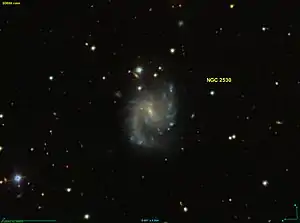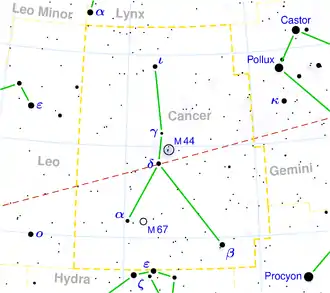NGC 2530
NGC 2530 ist eine Balken-Spiralgalaxie vom Hubble-Typ SBcd im Sternbild Krebs auf der Ekliptik. Sie ist schätzungsweise 220 Millionen Lichtjahre von der Milchstraße entfernt.
| Galaxie NGC 2530 | |
|---|---|
 | |
| SDSS-Aufnahme | |
| AladinLite | |
| Sternbild | Krebs |
| Position Äquinoktium: J2000.0, Epoche: J2000.0 | |
| Rektaszension | 08h 07m 55,6s[1] |
| Deklination | +17° 49′ 07″[1] |
| Erscheinungsbild | |
| Morphologischer Typ | SB(s)d[1][2] |
| Helligkeit (visuell) | 13,8 mag[2] |
| Helligkeit (B-Band) | 14,5 mag[2] |
| Winkelausdehnung | 1,4′ × 0,9′[2] |
| Positionswinkel | 170°[2] |
| Flächenhelligkeit | 13,9 mag/arcmin²[2] |
| Physikalische Daten | |
| Rotverschiebung | 0.016772 ± 0.000004[1] |
| Radialgeschwindigkeit | (5028 ± 1) km/s[1] |
| Hubbledistanz vrad / H0 |
(220 ± 15) · 106 Lj (67,6 ± 4,7) Mpc [1] |
| Geschichte | |
| Entdeckung | Wilhelm Herschel |
| Entdeckungsdatum | 22. Februar 1789 |
| Katalogbezeichnungen | |
| NGC 2530 • UGC 4237 • PGC 22827 • CGCG 088-038 • MCG +03-21-020 • 2MASX J08075560+1749062 • GC 1625 • H III 752 • h 487 • | |
Das Objekt wurde am 22. Februar 1789 von Wilhelm Herschel entdeckt.[3]
Weblinks
This article is issued from Wikipedia. The text is licensed under Creative Commons - Attribution - Sharealike. The authors of the article are listed here. Additional terms may apply for the media files, click on images to show image meta data.
